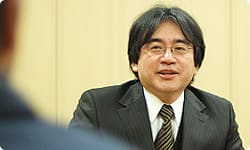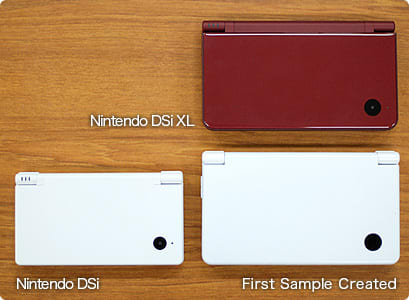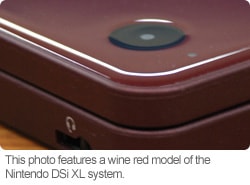The Image of a Bowl Full of Water
So in 2007, after the large version of the Nintendo DS Lite system was put on hold, development began for the Nintendo DSi. Kuwahara-san, it was your first time in charge of a hardware project, wasn't it?
That's right. And at that time, it had already been more or less decided that after we'd finished work on Nintendo DSi, we'd be making a larger version of it.
Due in part to the fact that it was me who had put the large-version of the DS Lite on hold, I said: "Let's release two versions of Nintendo DSi - a large one and a small one!" But of course, it wasn't possible to work on both of them at the same time!
Of course, to work on a large and small version simultaneously would have been absolutely impossible! (laughs) But while we worked on Nintendo DSi, while no one actually said it out loud, there was a feeling among the staff that we'd be working on a large version next. As the concept behind Nintendo DSi had been to make it compact and portable, we were getting more and more keen on having a large version! (laughs) For that reason, we wanted to set to work on making it right away.
When you set about making a larger version, I'd imagine that you begin by considering the size of the screens.
Yes, we started by sketching out the size of the LCD screens on scraps of paper.
So you made sketches on some paper to ascertain the size that the screens would be.
Right.
That's pretty lo-tech! (laughs)
We cut some card to the size of the Nintendo DSi XL system and then sketched the size of the screen on there, saying: "Something of about that size might be good..."
At that time, I was in China preparing for the mass-production of Nintendo DSi when I got an email from Kuwahara-san which was a scanned copy of some kind of a...really bad drawing.
(laughs)
At that time, I had my hands full with the Nintendo DSi, so I didn't have time to look at it.
So you were right in the middle of preparing for the mass-production of Nintendo DSi when you were asked to take part in the discussion about making a version with bigger screens. Well, if it hadn't happened like that, it wouldn't be released now.
That's right. Then at that point, we found we were able to use 4.2 inch LCD screens.
With LCD screens, the cost is decided by calculating how many screens you can get out of one large sheet.
LCD displays are originally manufactured on single large sheets of glass, which are then cut into individual panels.
Right. That's why it's vital to select a size that means you don't waste any.
But even though we were able to use 4.2 inch screens, there were quite a few people who voiced concerns, saying: "Won't the image on the screen look grainy?"
Actually, at the time of the announcement of Nintendo DSi XL, there were a lot of people who were incredibly worried that if we made the screens bigger while keeping the same resolution, you'd be able see blocky pixels on the LCD screens and the quality of the image would deteriorate greatly.
There were actually a lot of people who had the same concern within the company. So we had the LCD manufacturer come and give us a demonstration. After that, we realized: "It's fine, there's absolutely no problem!" Things also changed a lot when we decided to use the wide-viewing angle LCD displays.
Didn't you consider using wide-viewing angle LCD two years before when you were making the large version of DS Lite?
At that time, the cost of using it would have been prohibitive. But the price has come down in the last two years and it doesn't actually vary all that much in cost compared to LCD displays that don't allow a wide-viewing angle. So we decided to use it this time and when we actually tried it, we found that even when you look from the side, you could see the screen clearly, which was really great.
So the large screen and the wide-viewing angle LCD display are both a really good fit for the Nintendo DSi XL system.
Yes, they are.
So that was how you decided on the type of LCD display you would use. Did you then pass the baton to the design team?
We were actually moving at more or less the same time.
Those rough hand-drawn pictures would trickle my way and I'd be told to get on with designing them.
So when these roughly drawn images trickled your way, what were your initial thoughts?
I'm really embarrassed to show it to anyone, but I've actually brought the first sample I made. Here it is...
So you just made the Nintendo DSi system larger.
Yes, it's just a Nintendo DSi! (laughs) I tried out ideas like increasing the size of the corners to match the increase in size in order to give it a more balanced, softer overall feel but...
When he was making that, we actually came up with a proposal for the final design plan for Nintendo DSi XL. But Fujino-san was unable to decide...
So you couldn't make up your mind about which of the designs to actually use?
Right. I couldn't make up my mind.
Personally, I wanted him to decide one way or the other without delay so we could get it finished as soon as possible! (laughs)
(laughs)
So, Fujino-san, the dilemma that you faced was whether to just make a larger version of the Nintendo DSi, which would mean that a lot of the know-how from Nintendo DSi would already be in place in terms of development and manufacture. But if you'd done that, you would have risked people saying: "But it's just a bigger version!"
Right. Nintendo DSi was completed, and as this was part of the Nintendo DSi series, I knew that you couldn't leave it completely unchanged. But at the same time you couldn't change too much... Knowing where to draw that line was extremely difficult.
But there was also talk of making Nintendo DSi XL so people would want to leave it out on the tabletop. Simply making a bigger Nintendo DSi wouldn't really have made people feel like doing this.
So we went to furniture shops and other places like that to do research into the kind of thing we wanted...
So finally you hit upon the idea of accentuating the top panel, which keeps with the style of Nintendo DSi but also gives it a slightly different feel. The decisive factor in the end was the fact that this would make it more likely that people would want to leave it lying on the living room table, wasn't it?
Yes, that sense that if you left it on the tabletop, a member of the family would want to pick it up was really important.
When I first began working on the design, I made it so that the corners were bigger in order to give it a softer, gentler image. But when I did that, it ended up being enormous and seemed a bit unwieldy. I thought that I wanted to do something to improve this and found that by attaching a polished top panel to it, it retained that gentle look but was also smart and I aimed at a design like that. Furthermore, by making the top panel swell, I thought I'd bring out a sense that it was like a bowl full of water...
I see! So the image you had in mind was of the surface tension of water.
That's right.
But this top panel was actually extremely tricky to make.
Because of my willful insistence on this whim of mine, I ended up causing a lot of trouble for the rest of the team.




